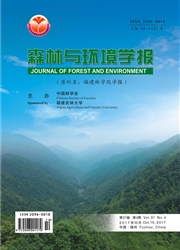

 中文摘要:
中文摘要:
全极化雷达图像的最大优点是能够获取目标的全极化散射特征,从而使其在地表植被的分类和森林参数反演中具有较大的应用价值。以紫金山国家森林公园为研究对象,2011年的全极化雷达数据、典型地类野外调查数据为主要信息源,在PAULI、SINCLAIR、CLOUDE-POTTIER、FREEDMAN-DURDEN四种目标特征值分解基础上,采用最大似然、支持向量机、神经元网络和随机森林4种方法进行监督分类。结果表明,5种组合中12个特征值组成的特征图像的最大似然分类的精度最高,总体分类精度为58.20%,CLOUDE-POTTIER、FREEDMAN-DURDEN总体分类精度较低,分别为51.86%、52.36%;4种分类方法中,12个特征值组合的图像的随机森林分类方法的总体分类精度最高,总体分类精度为74.29%,神经元网络的分类精度较低,总体分类精度为56.98%;6种地类中,针叶林、阔叶林和建筑的分类精度较高,草地、水体和裸地的分类精度较低。
 英文摘要:
英文摘要:
Since the fully polarimetric synthetic aperture radar image has a great advantage of being able to obtain the fully polarized scattering attributes of the target object, it is widely used in classification of forest vegetation and inversion of forest parameters. In the paper, Zijin Mountain National Forest Park in Nanjing was chosen as the case study area, while PALSAR image in 2011 and typical land use field survey data in the same year were collected as the main information source to do supervised classification. Four kinds of target characteristic value decomposition methods namely PAULI, SINCLAIR, CLOUDE-POTFIER, FREEDMAN-DURDEN were conducted, followed by supervised classification on the images comprised from characteristic values of target decomposition using 4 methods of mximum likelihood, support vector machines, neural net and random forest. Research results showed as follows. Among the 5 combinations of characteristic values, the overall classification accuracy of the image comprised of 12 characteristic values was the highest (58.20%), while the classification accuracy of the image from target decomposition of CLOUDE-POTFIER and FREEI)MAN-DURDEN was low (51.86% and 52.36%, respectively). Among the 4 classification methods using the image from 12 characteristic values, the overall classification accuracy of random forest was the highest (74.29%), while the classification of Neural Network was the lowest (56.98%). Among the 6 land use types, the classification accuracy of coniferous forest, broadleaf forest and built-up was high while the grass, water and bare soil was low.
 同期刊论文项目
同期刊论文项目
 同项目期刊论文
同项目期刊论文
 Interpretation of forest resources at the Individual tree level at Purple Mountain, Nanjing City, Ch
Interpretation of forest resources at the Individual tree level at Purple Mountain, Nanjing City, Ch 期刊信息
期刊信息
